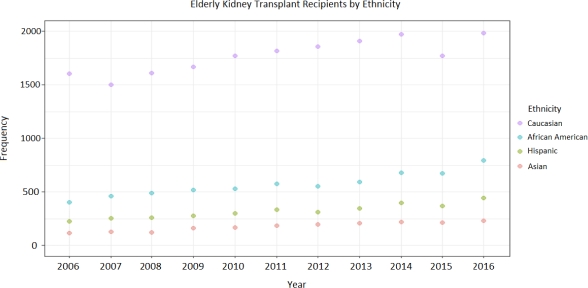Ethnic Disparities in Elderly Patients Receiving Kidney Transplantation
Henry Ford Transplant Institute, Detroit, MI.
Meeting: 2018 American Transplant Congress
Abstract number: B107
Keywords: Allocation, Elderly patients, Kidney transplantation, Waiting lists
Session Information
Session Name: Poster Session B: Kidney Deceased Donor Allocation
Session Type: Poster Session
Date: Sunday, June 3, 2018
Session Time: 6:00pm-7:00pm
 Presentation Time: 6:00pm-7:00pm
Presentation Time: 6:00pm-7:00pm
Location: Hall 4EF
Purpose: Over the past 10 years, the number of elderly kidney transplant recipients has increased. This analysis evaluates whether the trend is equitable across ethnic groups.
Methods: Data collected by the Organ Procurement and Transplantation Network was used to follow trends in kidney transplantation. The study population consisted of elderly patients aged 65 and older (E) transplanted between 2006-2016. Variables were stratified by ethnicity. Major ethnic groups were included [Caucasian (C), African American (AA), Hispanic (H), Asian (AI)]. Remaining ethnicities account for <2% of population and were excluded. Age, gender, total waitlist removal, waitlist mortality, waitlist times, donor type (deceased, living), patients receiving transplants, KDPI>85%, and education levels were analyzed. High education was defined as associates, bachelors, or graduate degree.
Results: 31656 patients aged 65 and older received transplants between 2006-16. C received more transplants from living donors and their wait was less than other groups when the wait time was less than 5 years (p<0.0001). When >5 years, there was no difference among groups. There was no difference in watitlist mortality among groups (p>0.05). There was no difference in the change of the waitlist proportions over the last ten years: C, AA, H, and AI maintain similar proportions (p<0.05). Ethnic groups received a similar number of >85% KDPI transplants over time (p>0.05). C had the highest levels of education when compared to other ethnic groups (p<0.0001). These disparities were not observed between genders in elderly patients (p>0.05).
However, there was a significant difference among ethnicities across years for the study population among transplanted C, AA, H, and AI (p<0.0001, figure 1). A post-hoc pairwise comparison revealed that it was due to the change of C, while the relative ratio of AA, H, and AI were the same across years (p<0.0001).
Conclusion: Elderly Caucasian patients are receiving more kidney transplants than any other ethnic group. They tend to have shorter wait times, receive more living donor transplants, and have higher levels of education. Increased awareness is needed to reduce this major disparity.
CITATION INFORMATION: Bajjoka I., Yaldo A., Crombez C., Abouljoud M. Ethnic Disparities in Elderly Patients Receiving Kidney Transplantation Am J Transplant. 2017;17 (suppl 3).
To cite this abstract in AMA style:
Bajjoka I, Yaldo A, Crombez C, Abouljoud M. Ethnic Disparities in Elderly Patients Receiving Kidney Transplantation [abstract]. https://atcmeetingabstracts.com/abstract/ethnic-disparities-in-elderly-patients-receiving-kidney-transplantation/. Accessed December 16, 2025.« Back to 2018 American Transplant Congress

